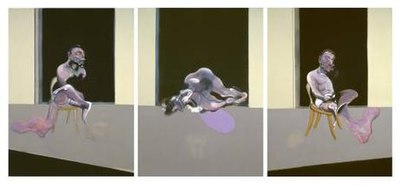

The Black Triptychs are a series of three triptychs painted by the British artist Francis Bacon between 1972 and 1974. Bacon admitted that they were created as an exorcism of his sense of loss following the suicide of his former lover and principal model, George Dyer.[1] On the evening of 24 October 1971, two days before the opening of Bacon's career-making retrospective at the Grand Palais, Dyer, then 37, alcoholic, deeply insecure and suffering severe and long-term depression, committed suicide through an overdose of drink and barbiturates in a room at the Paris hotel Bacon had allowed him to share during a brief period of reconciliation following years of bitter recrimination.[2]
Bacon, a near-alcoholic himself, felt an acute sense of mortality and awareness of the fragility of life after his former lover's death. This awareness was heightened by the death of many other close friends during the following decade. The most acute paintings after the loss of his friends are considered to be the many images of Dyer, including the three "Black triptychs", Three Portraits: Posthumous Portrait of George Dyer, Self-Portrait, Portrait of Lucian Freud of 1973, and numerous heads painted within three years of 1972.
The triptychs show, sequentially, the moments before, during and after Dyer's suicide.[3] The scenes are not represented linearly; they do not always read from left to right. Each shows a comatose man, collapsed or dead near the hotel room's lavatory seat. In most, Dyer is followed by black horizontal fleshy winged creatures, raw and red/pink blobs of dying flesh, or by painterly arrows. These devices act both as pointers to the depravity and tragedy of the scene and as manifestations of Bacon's guilt at the death of an emotionally dependent friend.
- ^ Dawson & Sylvester, 108
- ^ "Triptych - August 1972". Tate. Retrieved February 13, 2010.
- ^ Tóibín, Colm. "Such a Grip and Twist". The Dublin Review, 2000.